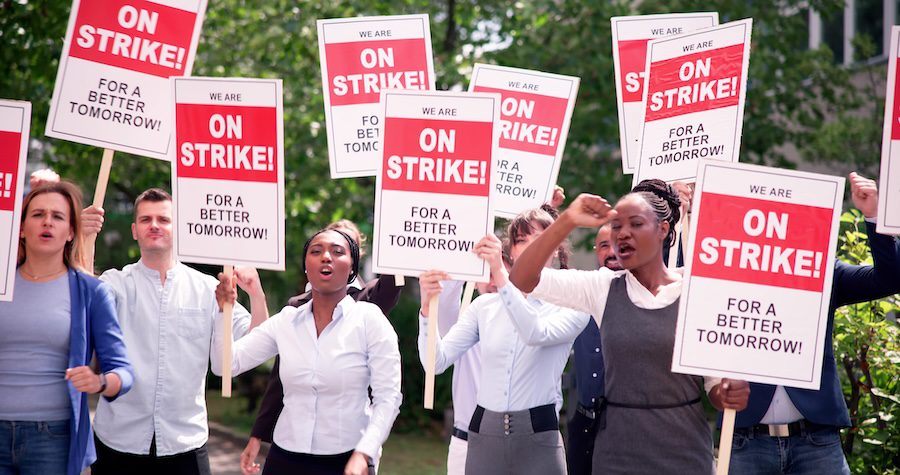Las Vegas is no stranger to unions that speak loudly and carry a big stick. Consider the Culinary Union– the moniker for the culinary workers, Nevada’s dominant union, and its small ally, the Bartenders Union. In May, the Culinary Union persuaded 700 workers to walk off the job for 48 hours at Virgin Hotels to compel the 1,500-room hotel-casino to negotiate an expired contract. And last year, before the Super Bowl in Vegas pitting the Kansas City Chiefs against the Philadelphia Eagles, the Culinary approved a Strip-wide strike to force talks over 10,000 nonunion workers. The Chiefs won, and so did the Culinary Union: the hotels and casinos owned by Caesars, MGM Resorts, and Wynn Resorts quickly came to terms.
The Nature of Labor Markets
In a sense, such spats in a free labor market are mystifying. After all, the worker can decline jobs that are not worth her time. And the firm can decline to hire a worker who produces too little to justify her paycheck. Thus, both employer and employee must be happy with the job offer before shaking hands. So why all the rage?
The answer is that the labor market is not always free or fair. The worker may not have other job offers in a “company town”—a labor market dominated by the employer. She must accept the monopolist’s wage offer or starve, even if she produces far more value than she receives in pay. (A “monopolist” is the only producer in a market.)
For example, the school district usually dominates the local market for teachers. Of elementary and secondary students in the U.S., over 90% are in public school districts, according to the National Center for Education Statistics. The school district is a monopolist that can set wages for teachers.
Solutions to Monopolies
The economist has two solutions to the problem of the company town. One is to break up the monopoly into smaller firms that will compete. The other is to bring competitors into its market. In either case, the producers’ struggle for market share will raise their demand for workers, as well as their salaries and benefits.
However, the path to such competition is not always straightforward. Breaking up a monopoly is a costly legal process for the government. To incentivize firms to compete for the monopoly’s profits, the government must ensure they can cover their startup costs, such as building an office tower and advertising for clients. Moreover, until they can become self-sufficient, the challengers must ensure that the monopoly will not drive them out by undercutting them in price.

In the case of the school district, the challengers don’t stand a chance. The school district is a legal monopoly. It is not possible to create another school system in Las Vegas that can offer free education.
When we can’t compete with the producer monopoly, consider plan B: confront it with a monopoly of workers. That’s the union. The individual worker can protest her salary only by threatening to quit; the employer will ignore the threat if he can easily replace her. But he cannot ignore a threat by all workers to quit. Unlike the individual, the union can bargain on equal terms with the firm.
Economic Consequences of Union Strikes
However, union strikes will burden the public, especially in the public sector. When the Chicago Teachers Union struck in 2012, school halted midyear for nearly 400,000 students. To avoid starvation by students who ate breakfast and lunch only at school, the Chicago system held half-days at 140 schools. But the quality of education still suffered.
“How dare you guys stop school in session?” said parent Gladys Hampton, according to NPR. “How dare you do that to our children? What are you thinking about? Not about them.” The quality of facilities can also suffer: the support staff for Chicago Public Schools, including janitors, struck for ten months, led by the Service Employees International Union Local 73.

In any event, strikes are costly for the public. When Chicago returned to in-class teaching in January 2022, following the lockdowns of the COVID-19 pandemic, the Chicago Teachers Union was on strike for five school days.
Alleging that the strike was illegal, a class action suit estimated its damages at $213 million. To arrive at this figure, the suit noted that the schools spent a daily average of $147 per student. It then assumed that since the schools spent this much, the value of education must be at least $147 per student per day. Canceling five school days incurred a social cost of 5 times $147 per student times the number of students affected, almost 300,000.
Is Raising Salaries the Answer?
In sum, public-sector strikes can stagger the public’s wallet. However, the pay hikes that often resolve a strike can also be costly because they can lead to unemployment. Why? Because the firm typically pays all workers in each category the same base salary. It thus profits by first hiring the most productive workers and then less and less productive workers until it breaks even on the last worker hired.

Raising the salary will cause the firm to fire the previous marginal worker because the wage exceeds the value of his work. In December 2023, the average hourly cost of an employee in the private sector was $57 for workers in unions and $42 for workers not in unions, according to an unidentified study cited by Statista. A union member was a third more expensive for the firm than a nonunion member. In Las Vegas, the Culinary Union’s new five-year contract would boost salary and benefits by one-third, from $28 per hour to $37.
Long Term Issues with Unions
If unions do create unemployment, then the most unionized states should have high unemployment rates, and that does seem to be the case. In 2023, an increase in the unionization rate by ten percentage points related to an increase in the unemployment rate of half a percentage point, according to my simple statistical model.
Unions also lead to long-term problems through no fault of their own. Negotiations between the firm and the union often agree on generous pensions because the negotiators get the credit while passing on the costs to future executives.
The Chicago Case Study
In Chicago, the average teacher draws a pension of $73,350 per year. The total pension payout for one teacher averages $2 million. In principle, the Chicago teacher contributes 9% of the salary to the pension. In practice, the schools pay seven percentage points of that. The teacher pays only 2% of salary towards her retirement. The rest comes from Chicago Public Schools, i.e., from Chicago taxpayers.
By fiscal 2023, the pension fund could finance only half its liabilities. And the gap was growing. That year, the fund took in $1.1 billion but paid out $1.6 billion, spilling $500 million of red ink. The total unfunded liability was $13.8 billion on a liability of $28 billion.

Even legal deadlines cannot prevent negotiators from playing games. By state law, the Chicago teacher pensions fund must finance 90% of liabilities by 2059. At that level, teachers no longer would have to contribute to the fund. But the fund projects that its funding share will not increase until 2048 – and then it will rise steeply. If the fund overestimates its ability to pay bills, the difference must come from pensions. Otherwise, the fund must default. That would endanger Chicago city bonds that already have been graded as junk.
Unions in Nevada
In Nevada, teachers pay 12.25% of their paychecks into the public-sector pension system; police and firefighters pay 20.25%. It is not hard to imagine that the public-sector union, the American Federation of State, County, and Municipal Employees, might press for reduced obligations. Nevada teachers do not receive Social Security.
Unions do have benefits, of course. They have an incentive to monitor dangers to the workforce that no one worker finds worthwhile to monitor. Similarly, they have an incentive to adopt benefits to the workforce that no one worker can undertake. For example, the Culinary’s new contract in Vegas would offer retraining to workers who lost their jobs.
But the unions’ interference with the free market threatens the consumer with the same pain that the monopoly seller inflicts—high prices and low supply. Las Vegas is no stranger to these conditions, either.

